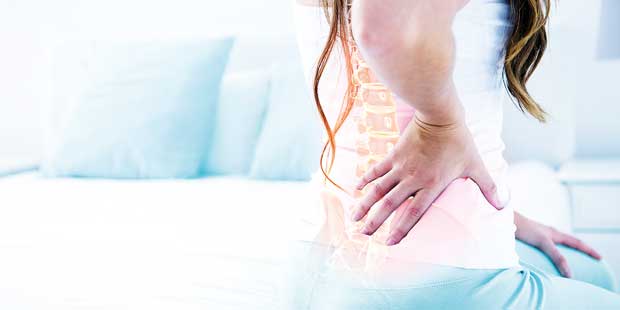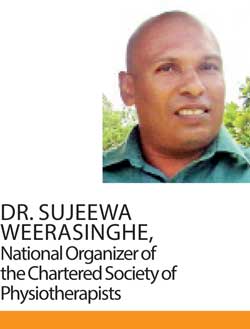Reply To:
Name - Reply Comment
Last Updated : 2024-04-19 15:52:00

 Lower back pain is a common problem, so if you suffer from it, you are not alone. Managing low back pain may not be simple. You need to be aware of a number of factors which will help you decide what to do to in terms of treatment. This week Health Capsule spoke to Dr. Sujeewa Weerasinghe, National Organizer of the Chartered Society of Physiotherapists, to bring you more knowledge on how to cure lower back pain.
Lower back pain is a common problem, so if you suffer from it, you are not alone. Managing low back pain may not be simple. You need to be aware of a number of factors which will help you decide what to do to in terms of treatment. This week Health Capsule spoke to Dr. Sujeewa Weerasinghe, National Organizer of the Chartered Society of Physiotherapists, to bring you more knowledge on how to cure lower back pain.
Lower back pain affects people of all ages from children to the elderly. This ailment is a frequent reason for patients to seek medical consultations. The 2010 Global Burden of Disease Study estimated that low back pain is among the top 10 diseases and injuries that account for the highest number of DALYs (The Disability-Adjusted Life Years) worldwide.

It is difficult to predict when lower back pain will occur. The first episode of this ailment can come when you are a boy or during adulthood. And after being diagnosed with lower back pain the symptoms tend to recur over a period of time. The lifetime prevalence of lower back pain is estimated at 60% to 70% in industrialized countries (one-year prevalence 15% to 45%, adult incidence 5% per year). The prevalence rate for children and adolescents is lower compared to adults, but is rising. Prevalence increases and peaks between the ages of 35 and 55. As the world’s population ages, lower back pain will increase substantially due to the deterioration of the intervertebral discs in older people. In most instances of lower back pain, the problem may settle within a few weeks. However, many people are still affected by pain in some way throughout the year. Flare-ups are also very common. Though you recover despite not taking medication it is advised that you seek medical assistance.
Causes
The back is a complicated structure comprising bones, joints, ligaments and muscles. You can sprain ligaments, strain muscles, rupture disks, and irritate joints, all of which can lead to back pain. While sports injuries or accidents can cause back pain, sometimes the simplest of movements—for example, picking up a pen from the floor— can have painful results. In addition, arthritis, poor posture, obesity, and psychological stress can cause or complicate back pain. Back pain can also directly result from disease of the internal organs, such as kidney stones, kidney infections, and blood symptoms.
Signs and symptoms are: Muscle ache, shooting or stabbing pain and pain that radiates down your leg.
Back pain for many people is often experienced as a pain or discomfort located between the lower ribs and buttocks with or without the addition of leg pain. Symptoms can range from muscle ache to shooting pain, limited movement, altered walking and difficulty in standing straight. If sciatica occurs along with a back problem, nerve pressure is experienced as pain that radiates down the leg and possibly into the ankle or foot. A sensation of being pricked with pins and needles and even numbness can be felt.
Acute lower back pain generally lasts for a few days to weeks and is usually caused as a result of trauma or arthritis. Lower back pain that persists for longer than 3 months is considered chronic.
Back exercises are almost always necessary to rehabilitate the spine and alleviate back pain. A controlled, gradual exercise program that is tailored to an individual is usually the most effective. Limited flexibility or range of motion of the back lots, or bone loss cause lower back pain. A typical response to back pain is to take it easy either by staying in bed or least refraining from performing any strenuous activity.
A frequent question asked is why the lower back is so prone to injury?
The lower back is subject to injury while lifting a heavy object, twisting, or when forced to do a sudden movement. Any one of these activities can cause the muscles or ligaments to stretch or develop microscopic tears. Over a period of time, poor posture or repetitive stress can also lead to muscle strain or other soft tissue problems. And while muscle strain sounds simple, pain in the lower back area can be severe.
Relieving pain
Physiotherapy can help you overcome lower back pain. Physical Therapy (PT) involves treatments that focus on prevention and management of injuries or disabilities. PT helps to relieve pain, promote healing and restore function and movement.
PT is practiced by a professionally trained physical therapist. A physical therapist is a specialist skilled and educated specifically in evaluating and conservative management. The goal of physiotherapy is to restore pain-free movement and to help you maintain this improvement long-term. Physiotherapists use a range of modalities to achieve these goals. These can encompass things such as hands-on type treatment, exercise therapy, dry needling or electrical modalities to name a few. Recovery can take time and can be related to various factors. These include the severity of the problem and also the state of your tissue prior to injury. For example, if you are a 55-year-old manual worker, your spinal tissue may be degenerated (worn out) prior to injury. This may mean a slower recovery than in a 21-year-old with less degenerative changes in the spine. Other contributing factors can include your general health, your weight, whether you are a smoker, your fitness and if you suffer from depression. One of the biggest risk factors in suffering a back injury is a previous back problem. You need to continue with general fitness and do ‘core’ exercises long after you recover from your back injury. This helps prevent lower back pain from recurring.
Another popular question asked is how Physical Therapy is used to treat pain? An important aspect to keep in mind about physical therapy and pain relief is that each individual may respond differently to therapy. People have different types of bodies, different patterns of movement and different habits. Physical therapists and their trained staff can monitor each individual and correct improper habits and movement patterns.
A therapist may focus on decreasing pain using either passive or active therapy.
Examples of passive physical therapy include:
Manual therapies, Heat/ice packs and Electrical stimulation (including TENS units) and Ultrasound.
Examples of active physical therapy include: Movement based activities, including stretching and range of motion exercises, Specific strengthening exercises, Pain relief exercises and Low-impact aerobic conditioning.
Posture and work
Your posture and the work you do can contribute to the development of lower back problems. Prolonged sitting, working in a bent forward position and heavy or repeated lifting can all be factors in you developing a back problem. These need to be addressed if you want good results.
Benefits of exercise
When done in a controlled, progressive manner under the supervision of Physiotherapist, exercises for relieving back pain have many benefits. They include: Strengthening the muscles that support the spine, removing pressure from the spinal discs and facet joints, alleviating stiffness and improving mobility, improving circulation to better distribute nutrients through the body (including the spinal discs), and releasing endorphins (which can naturally relieve pain). A frequent release of endorphins can help reduce reliance on pain medication. Endorphins can also elevate mood and relieve depressive symptoms, a common effect of chronic pain.
Resting for more than a day or two can actually undermine healing and worsen pain. Engaging in exercise and fitness activities helps keep the back healthy by allowing the discs to exchange fluids which is how the discs receive nutrition. A healthy disc will swell with water and squeeze it out, similar to the action of a sponge.
Exercising using a prescription
An effective exercise program targeting the back should be comprehensive. It should work the whole body even as it targets the back. Exercise can be thought of in the similar manner like any other health prescription: A qualified health professional will customize exercise based on a variety of factors.
These factors typically include: The clinical diagnosis, whether pain is considered mild, moderate, or severe, whether the pain relief is necessary to tolerate activity and the frequency of prescribed exercises.
Maintaining exercise program
Adherence to exercise is one of the most important factors for long term pain relief. However, maintaining an exercise programme can be difficult for a variety of reasons, including pain worsening with activity, economic constraints and low motivation. In one study, the most common reason for lack of adherence to exercise was increased pain caused by activity. When this is the case, an exercise professional can incorporate pain reduction and management as primary parts of the exercises.
Tips to prevent pain
Exercise your core. Strong core muscles are important to provide support for the lower back and avoid injury. Low-impact cardiovascular exercise—like exercise walking—increases blood flow to the spine, which supplies healing nutrients and hydration to the structures in your lower back.
Correct your posture.
Poor posture places pressure on your back and can cause degenerated discs to become more painful. Support the natural curve in your lower spine by using an ergonomic chair and set a timer on your phone to remind yourself to check your posture as your work throughout the day. Make sure to get up and walk around at least once an hour if you sit most of the day. If you can, use a standup desk for at least part of the day.
Lift heavy objects correctly. Even if you’re young and strong, you can still injure your lower back if you lift a heavy object incorrectly. If you don’t know the proper technique, see Avoid Back Injury with the Right Lifting Techniques.
Be a savvy athlete.
No matter how fit and athletic you are, a wrong move could injure your lower back. Make sure you understand the potential lower-back pitfalls of your favorite sport
Improve your overall physical health. The spine reflects the overall health of your body. Anything you can do to improve your overall physical fitness and general health will benefit your lumbar spine as well—including drinking lots of water, minimizing/not drinking excessive alcohol, eating an anti-inflammatory diet (or less inflammatory), and stopping smoking/avoiding any nicotine intake.
Stretch your hamstrings.
A little-known cause of low back pain is tight hamstrings. Simple hamstring stretching exercises can help decrease the pressure on your pelvis and provide relief across your lower back. Not all forms of hamstring stretching are good for all types of backs though, so check with your physical therapist first. Many modifications are available.
Learn how to be a defensive driver.
Brush up on your defensive driving skills and always have a plan to get out of a bad situation on the road.

Add comment
Comments will be edited (grammar, spelling and slang) and authorized at the discretion of Daily Mirror online. The website also has the right not to publish selected comments.
Reply To:
Name - Reply Comment
On March 26, a couple arriving from Thailand was arrested with 88 live animal
According to villagers from Naula-Moragolla out of 105 families 80 can afford
Is the situation in Sri Lanka so grim that locals harbour hope that they coul
A recent post on social media revealed that three purple-faced langurs near t